BY DEBRA KEEFER RAMAGE
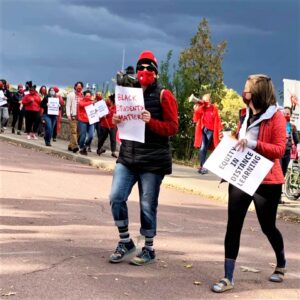
St. Paul Federation of Teachers, Lake Street Bridge, Sept. 30
It’s a complex landscape. You have the institutions—district public schools, public-private charter schools, alternative, private and parochial schools, as well as the districts themselves and some contractors that fill in essential services, like food preparation or bus transportation. Then you have the stakeholders—students, families, teachers, other staff, both direct and contracted, and their various unions. “Other staff” is a huge collection of people: teaching assistants, substitute teachers, counselors, administrators, social workers, cleaning staff, bus drivers, nutritionists, coaches, librarians, language specialists, safety specialists and food service. The two “new” learning modes—hybrid and remote—can increase the needs for some staff while decreasing the needs for others. (More on that later.)
What’s it like being a district superintendent or school board member, a charter school principal or private school administrator, or the parent or guardian of a student in these fraught times? It feels like the expression “moving target” falls short. Imagine, if you will, an archery course where the targets move around, but also which target you’re aiming for changes at random intervals, and the width of the rings and the size of the bull’s
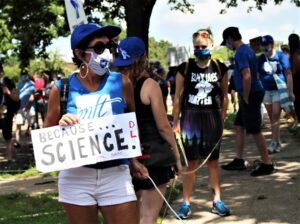
Teachers rally summer 2020
eye constantly changes on each target. And also, you are wearing independently powered skates that move you around in a random manner, and some of your arrows are actually disguised boomerangs. That’s what making learning-model decisions for students is like right now. And it’s not only a potentially life or death decision, it’s also a quality of life (for the rest of their lives) decision.
Gov. Walz and his Education Department declined to make that decision for the whole state. Instead they issued these guidelines.
School districts and charter schools (each of which is treated as its own district within the meaning of the act) are required to follow the guidelines. If they opt for only distance learning, they are fine, but if they
want in-person or hybrid, they need to justify it with epidemiology data, reasons for exceptions, and their own detailed safety plan. Private and
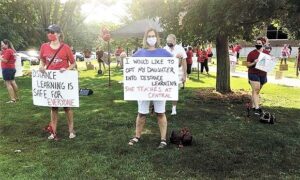
White Bear Lake educators demo for distance
parochial schools are “encouraged” to follow the guidelines but don’t have to report to the state. Get a PDF of the guidelines here: tinyurl.com/yyr4wbl8
In terms of school districts, the three largest in the state are all here in the Twin Cities. Anoka-Hennepin (ISD 11) with 50 schools and 38,802 students, St. Paul (SPPS) with 99 schools and 36,888 students, and Minneapolis (MPS) with 100 schools and 36,370 students. ISD 11 originally opted for the hybrid learning model, but delayed opening a week. They also kept grades 7 through 12 in full-time distance learning the first two weeks. Both MPS and SPPS went with full distance learning,
although COVID rates before Labor Day (i.e., before the post-holiday
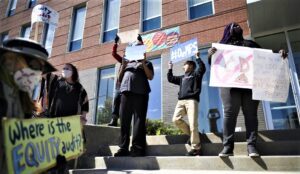
Protest against CDD in May
uptick) would have qualified them for hybrid. In the Twin Cities, Bloomington and Roseville districts also chose full distance.
Only one metro area district—Dassel-Cokato (ISD 455) with four schools, fewer than 2,300 students, and spanning the rural counties of Wright and Meeker—is going full in-person learning. The rest, and the majority of charters, either chose hybrid across all grades, or in-person for grades pre-K through 6 and hybrid for the rest. However, by state guidelines, even if a school is full in-person, any student who requests it must be provided a full distance program as nearly equivalent as possible.
Teachers largely prefer full distance learning programs, and it’s easy to see why. For one thing, they must provide distance learning in any case, and the thing most teachers worry and complain about—and in many cases, organize against—is the uncharted stress of having to provide two or three separate lesson plans with very different material needs and challenges. Many teachers have seen their already long days greatly expanded. They have seen their unmet lists of materials needed also expand, and often end up paying for them themselves. Teaching in person during a pandemic is putting them in a frontline position similar to some health care workers, but without PPE, training or hazard pay.
Many support staff, on the other hand, have hourly jobs that cannot be done remotely, and may not be required in the case of distance learning. Others are required but often even more than usual, and also with high health risks. These workers have even more tough choices—change jobs, go work for a more suburban or rural district that’s having in-person classes, or try to subsist on unemployment and food shelves until the pandemic is over. With so little safety net, either choice is a fearful gamble. What if in-person learning leads to such a rise in school-based COVID cases that all in-person learning shuts down? What if the support staff person themself gets sick? What if they bring the virus home to their family?
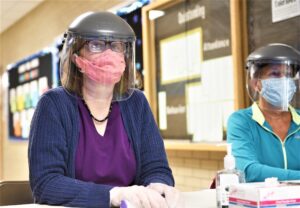
Staff greeting in-person learning students.
Families and students face a similar gauntlet of scary options. Many schools are missing students they had last year and expected back. Did they move to another district? Opt for a charter school because they want some in-person learning but the district is all distance? Go to a parochial school because they want full in-person learning? Decide to homeschool if they’re going to have the kids at home anyway? Or is it just part of the normal American mobility schools cope with every year?
In Minneapolis, this uncertainty is further compounded by the fact that the district is forging ahead with the unpopular Comprehensive District Design or CDD. This program is doing away with or greatly reducing combined elementary-middle schools, open schools, and magnets and the free bus transportation that supports them. Only English language learners can now be bused across boundaries of the district’s subsections. (However, with full distance learning, the only thing being bused at all right now is school meals.)
I interviewed two workers in the center of this upheaval—a teacher and a part-time school bus driver. The teacher is currently in MPS, and the bus driver works for First Student, the large contracted school transportation company which is international in scope.
Beth is now in her tenth year of teaching at middle school level. Her previous nine years have been with two consecutive charter schools. She just recently quit the second charter school to take a similar job with MPS because she could not handle the workload and risks required for hybrid teaching. She described to me the incredible amount of work involved in a complex model of hybrid learning. One thing that stood out for me—teachers themselves were required to deep clean their workspaces in the small amount of downtime (ha ha) between classes. I thought of all the out-of-work cleaners in the area, and could not fathom why the school wouldn’t contract that out, and I wondered how many teachers they lost when this was the final straw. Penny wise and pound foolish, perhaps, as the Brits say?
For Beth and other teachers in MPS and SPPS, there is still a greatly increased workload involved in providing distance learning. They are cognizant, too, of the huge inequities in access to not only technology, but also basic school supplies and even a space at home conducive to learning. (Even before the economic catastrophe of COVID shutdowns, MPS and SPPS had alarmingly high rates of students who were unhoused, housing insecure, and food insecure.) Beth said the social workers in the system are “run ragged” delivering supplies and making home visits.
The school systems are not ignoring these inequities. Every student in MPS is entitled to a Chromebook, and either a hotspot or greatly decreased rates for “internet essentials” (which are metered, adding another layer of stress for families who need them). SPPS and suburban systems all have similar programs, and charities also step in to help. In a recent story for MPR, mprnews.org/story/2020/09/23/as-classrooms-go-online-theres-more-to-the-digital-divide-than-who-gets-a-hotspot, Riham Feshir detailed the gaps in both metro and outstate students’ families, and highlighted the additional equity work of Ini Augustine, a Minneapolis network engineer and business owner who has been helping families with limited access to online learning. Her volunteer work includes parents who have experienced homelessness, and whose children need not just electronic devices, but desks, school supplies, food, and even hotel rooms. “You’re not going to set a child up for internet for school in a home that has no electricity,” Augustine remarked.
KH has been driving school buses for First Student since he retired. Many school bus drivers are retirees or on part-time employment due to disabilities, so the work-or-don’t-work dilemma is particularly pointed for them. Also, as KH pointed out, hourly-paid support staff such as cleaners, bus drivers, food service workers and teaching assistants are more likely to be POC than teachers, who are still a majority white even in districts with a majority of students of color. And who is most at risk for COVID-19? Elderly people, those with certain disabilities and some communities of color.
KH normally drives a route for SPPS, where First Student contractors are represented by Teamsters Local 120, while a fleet of direct district employed drivers is represented by Local 320 of the same union. Since KH wanted to continue driving, despite his risk status, he opted to take a route in White Bear Lake, where the learning model is hybrid. By state guidelines, buses are operating at 50 percent capacity, riders and staff are masked, and the buses are deep-cleaned between each pickup. KH is very cognizant that his needs to keep working are at odds with his comrades in the teaching profession and teachers’ unions. (First Student, by the way, is still desperate for bus drivers. Check their website for current openings.)
Parents are ambivalent, and span the full spectrum from all in-person to all distance in preference, with homeschooling also in the mix and on the rise. Well-known Minneapolis school activist and parent Sarah Lamm posted this on Facebook:
“I’d love to know more about what online/hybrid teaching is like here in MPS. I know my 6th grader’s MPS specialist class has 150+ students in it. I also know a 6th grade teacher quit a few days before school started, and that another teacher who already has 153 students of her own is picking up the slack—apparently because MPS will not hire any short-term subs during distance learning. That means there is a 3-hour gap each week, thus far, for 6th graders at ****, because the teacher who is providing content already has other classes to teach…
“Is this approach sustainable? And why isn’t MPS dropping everything (including CDD planning/modeling/PPT presentations) to focus on providing more support to families, teachers and kids?”
As this complex story unfolds, teachers, administrators and support staff are all confronting the money-driven contradictions and paradoxes they face. Education Minnesota, the state’s largest teachers union, said “schools should consider pumping the brakes on planned in-person instruction” just a week before the first school openings. And on Sept. 30, educators from Minneapolis (MFT Local 59) and St. Paul (SPFE Local 28), along with many supporters from the community, met in the middle of the Lake Street-Marshall Avenue Bridge at rush hour to demand no hybrid learning until safety precautions can be made for all members of the school community, free and reliable internet for all families, hazard pay for frontline staff providing child care, and other key requirements for equity and safety.























